Lettuce is one of the easiest vegetables to grow in containers, indoors or in your outdoor container garden. It's perfect for growing in classroom gardens and at home with your kids. Discover how to grow this cool-weather crop year round when you use containers!
Lettuce is one of the best vegetables for container gardening and for growing with children. The plants are relatively small and fast maturing so your child or students don't need to wait months and months to see the results of their hard work.
Homegrown lettuce can also be a great way to encourage your children to eat more vegetables. Homegrown heads of lettuce taste so much better than anything from the store!
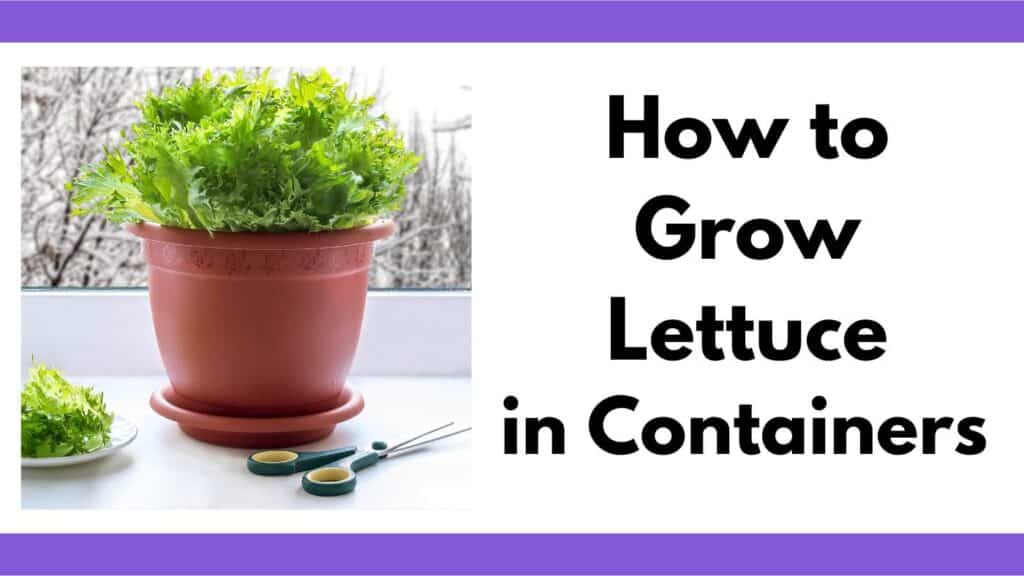
This post may include affiliate links which means I may earn a commission on qualifying purchases at no additional cost to you.
Table of Contents
Lettuce Growing Info
Lettuce (Lactuca sativa) is an easy-to-grow green that thrives in cool weather. Gardeners in cooler climates can grow it outdoors practically all year, while those who have warm summers can plant it as a spring and/or fall crop (and sometimes as a winter one). Because it tolerates partial shade, lettuce can also be grown in a sunny window or with a small grow light indoors.
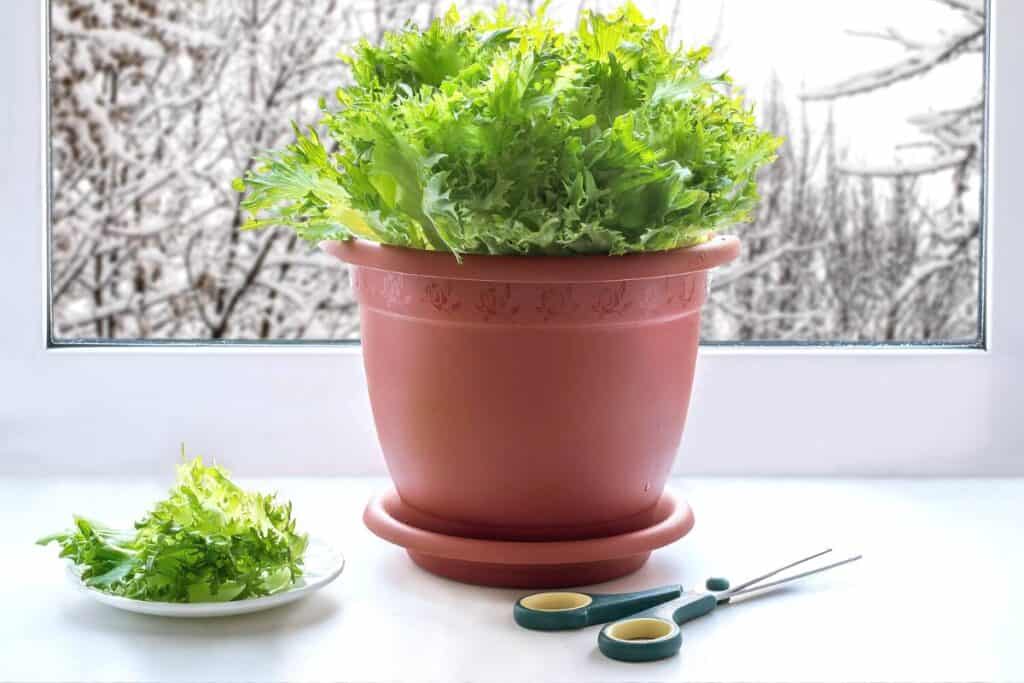
If you're growing outside, it’s important to get your plants going early in spring so that they can mature before the weather gets hot. In the Southeast, you can also plant in fall for an early winter harvest.
Once the temperatures are consistently over 80°F, your plants are likely to bolt, which means they send up a flower stalk and the leaves turn bitter. You can learn more about bitter lettuce and what to do about it in this post.
Before planting, you’ll want to consider whether you want to grow lettuce as a cut-and-come-again crop or if you want to harvest the entire plant. The photo of lettuce indoors in winter shows a cut and come again harvest.
The first option will give you a continuous harvest of individual leaves for as long as your lettuce plants last. This method works best for loose leaf lettuce. Other varieties with compact heads, such as iceberg and romaine, are typically harvested whole.
I personally prefer growing cut and come again lettuces in small containers. You don't need as much space per plant because it never reaches its potential full size.
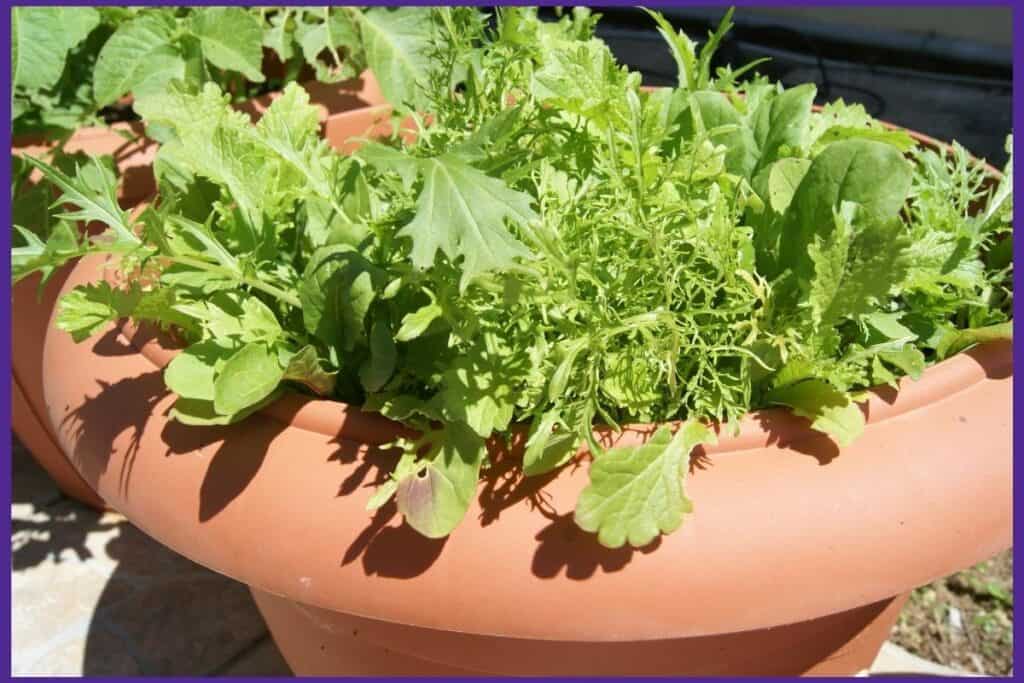
Benefits of Growing Lettuce in Containers
There are several reasons to plant lettuce in pots.
Using containers allows you to get a jump on the growing season. Even while the soil in the garden is still too cold to plant in, you can add soil to pots and get going a week or two earlier. Locating containers next to your house also helps shelter lettuce from harsh weather early in spring.
If you want fresh greens in warm weather, growing lettuce in containers allows you to grow indoors.
Another reason to keep your lettuce in containers is convenient harvesting. Put your pots near your back (or front) door to easily pick a salad whenever you want to.
Finally, container-grown greens are less likely to suffer from pest damage than those in the garden. This goes for pesky insects as well as bigger critters like deer and rabbits. Place pots on a porch, deck, balcony, etc. for the most protection against hungry critters.
Types of Lettuce to Grow in Containers
Practically any type of lettuce can be grown in a container. Some do get larger than others, so you’ll need to consult your seed packet for the proper spacing when you go to plant, but all have shallow roots that adapt well to a pot.
Here are some of the different types of lettuce you may want to consider:
- Loose Leaf- One of the best varieties for cut-and-come-again lettuce. Matures in only 40-45 days and comes in both green and red cultivars. Salad bowl is my favorite loose leaf lettuce to grow. Its more heat tolerant than many varieties and does well in containers.
- Butterhead- A favorite among gardeners for flavor. You can harvest individual leaves or wait for the loosely packed head to form.
- Romaine- Popular crisp variety used in Caesar salads. Often harvested as a head but can also be cut-and-come-again. Little gem is an adorable romaine-type lettuce. Its miniature size makes it perfect for container gardening.
- Iceberg- Often seen in the grocery store. Matures into a medium-size tightly packed head.
- Bibb- Generally grown for mini heads, this lettuce is very tender, sweet, and compact.
- Oakleaf- Unique lettuce with leaves that are lobed and shaped like oak leaves.
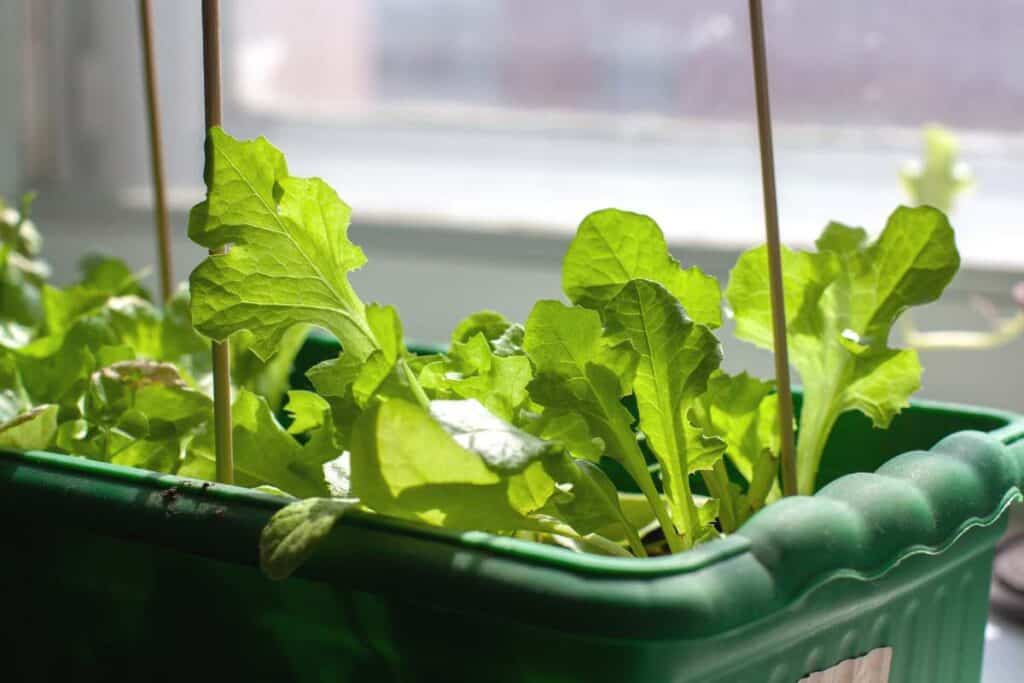
How to Grow Lettuce in Containers
Choosing the Right Pots
Lettuce has fairly shallow roots and will grow well in a container that is only about 6-8” deep. The plants will need to be spaced 4-10” apart, depending on the variety, so choose long and shallow containers to maximize your growing area. Window boxes are ideal for growing lettuce.
Lettuce also lends itself well to improvised and upcycled containers. You can have your students bring in things like milk jugs and large yogurt containers to create your classroom lettuce container garden:
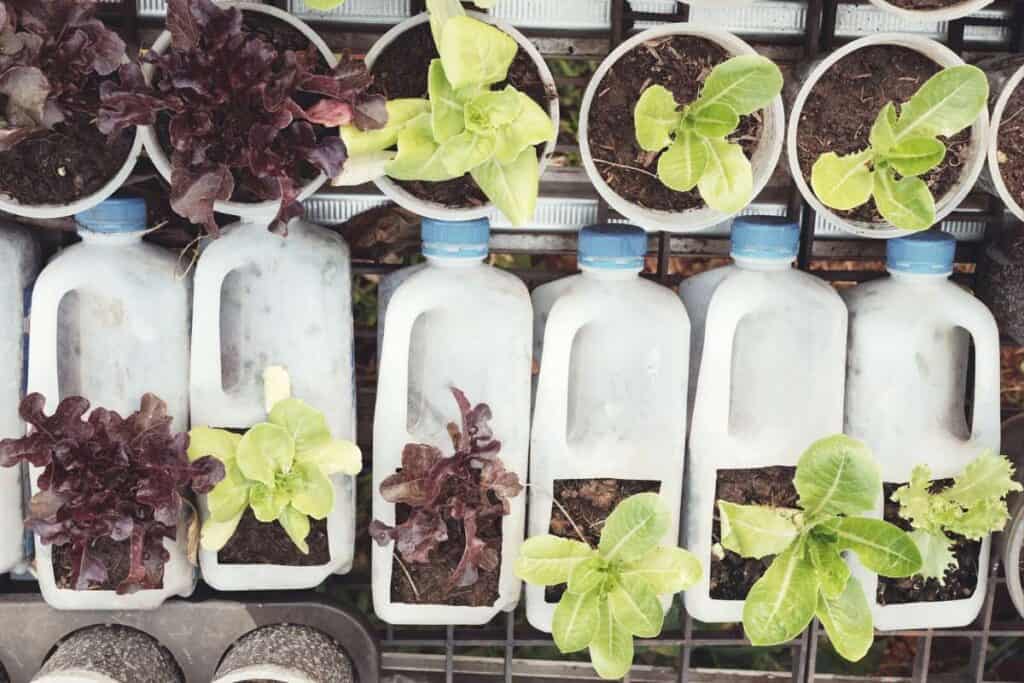
If you only have large containers, that's okay. Lettuce will not be harmed by a deeper container, you'll just have to use more soil. Below you can see a repurposed container with lettuce seedlings:
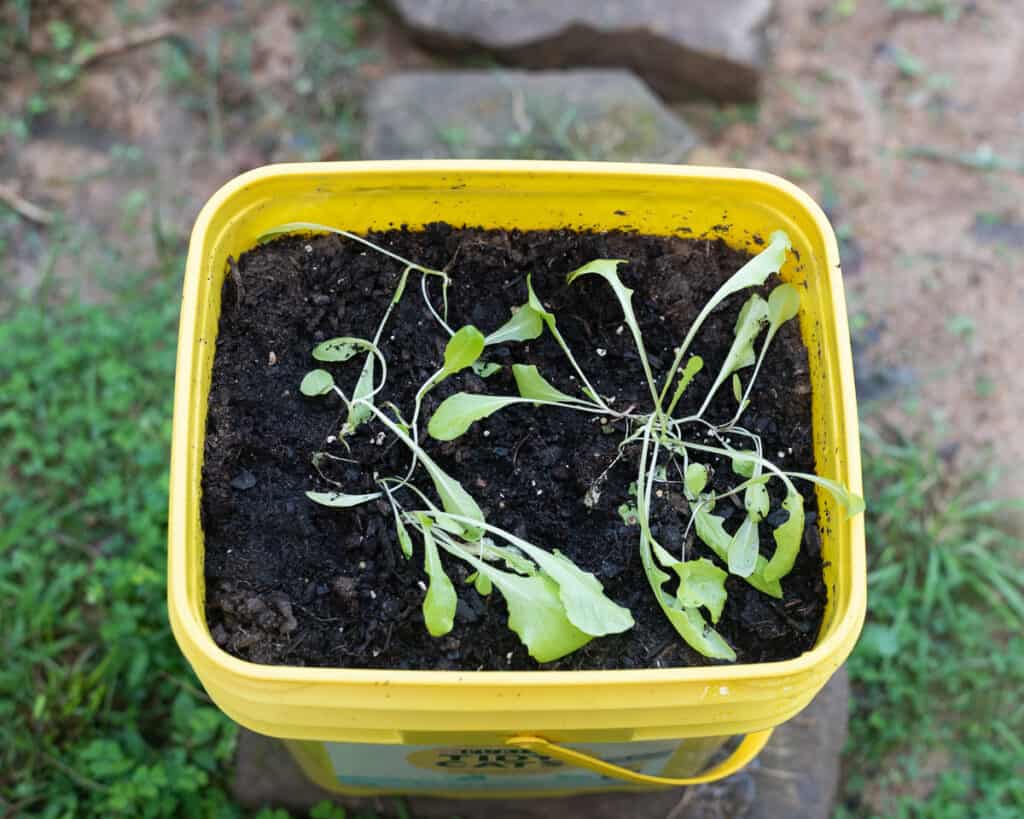
If you want to grow lettuce in individual containers instead of larger ones, you can put one plant in a pot that is at least 6” deep and 6” across.
When choosing your containers, make sure they have drainage holes in the bottom or drill your own holes before planting. Good drainage is essential for container-grown plants to make sure they don't get root rot from soggy soil.
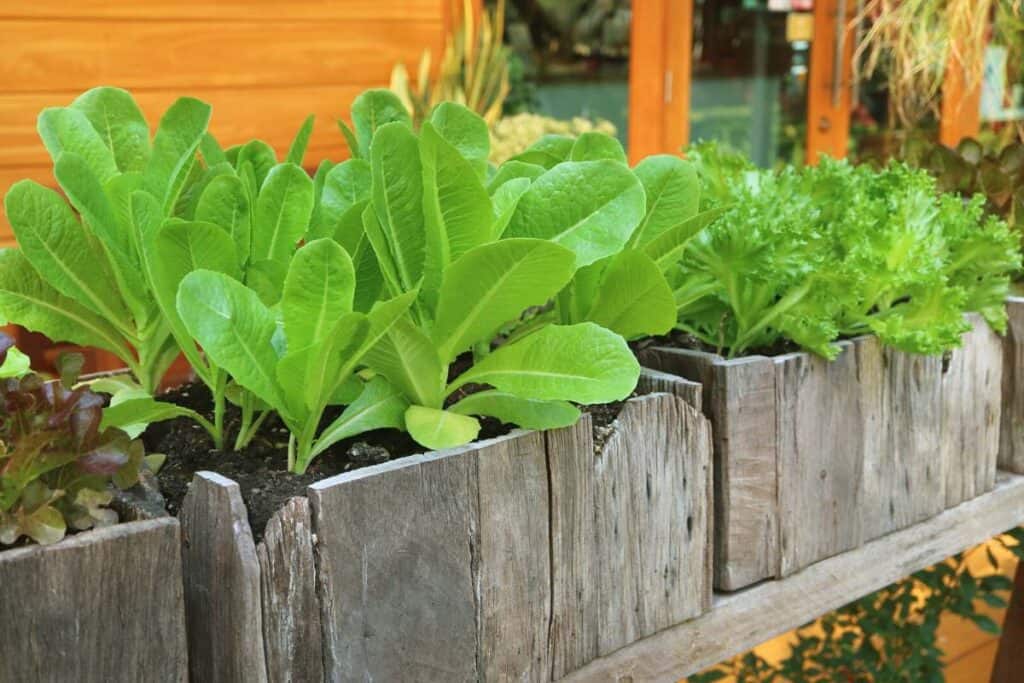
When and Where to Plant Lettuce
Your first round of lettuce can be started outdoors in early spring about 2-4 weeks before your last spring frost date. For a fall crop, start seeds indoors in late summer and plant seedlings out in early fall.
To make sure you have a steady supply of salad greens for most of the season, continue to plant lettuce at 2-week intervals after the first round. This is called sucession planting.
Ideally, place your containers where they will get full sun, which is at least 6 hours of sunlight each day. However, lettuce does tolerate more shade than most vegetables, so don’t worry if you can’t give it a full 6 hours.
If you have the ability to move your pots around, shift them to an area that gets morning sun and afternoon shade when the temperature gets above 80°F. This will help to keep your plants from bolting.
Sowing Your Seeds
You can buy lettuce seedlings from a nearby nursery for easy planting, but it’s also very simple to learn how to grow lettuce in containers from seed.
The first step is to fill your pots with a good quality potting soil that drains well and contains plenty of organic matter. Then, plant your lettuce seeds ¼” deep and cover them lightly with soil. Check your seed packet for their correct spacing, which is usually 4-10” apart. Lettuce can be planted more closely if you plan to eat it as baby greens. You can eat any thinned lettuce plants, even the very smallest ones, so don't worry too much about closely spaced seeds.
Lettuce grown for heads should be spaced further apart than for cut-and-come-again leaves.
Alternatively, you can start your seeds early indoors about a month before you want them to go outside. You can either plant them directly into the containers you plan to take outside or plant them in a plug tray and transplant them later.
Whichever method you choose, keep the soil moist while your seeds germinate. If you have more than one seedling come up in the same spot, thin out the weaker-looking one.
Care Tips for Container-Grown Lettuce
The biggest care task you will have for your lettuce is to water it during dry weather. Lettuce needs consistently moist soil to stay tender, and the soil in containers will dry out more quickly than the soil in a garden. Some people even water with cold water during high temperatures.
To check if your lettuce needs to be watered, stick your finger a few inches into the soil. If the soil at your fingertip is dry, it’s time to water. I prefer to water with a watering wand. It provides a more gentle spray that doesn't blast plants out of the ground or break delicate lettuce leaves.
- IDEAL CHOICE. The GREEN MOUNT sprayer wand is ideal for watering bushes, gardens and shrubs. It dose have a nice curve along the wand and gives a nice...
- NEW DESIGNED SHOWER HEAD. Especially 661 holes are perfect for delicate flowerbeds and seedbeds. The head is fully removable which allows to break...
- EVERYTHING IN REACH. Hose wand allows you to water over, under, and around where traditional nozzles can’t reach.
If your potting soil contained fertilizer or compost, you won’t need to fertilize any of the quicker-growing lettuce varieties. However, if you are growing a type that forms a full head, feed it with a nitrogen-rich, liquid fertilizer every 3 weeks. I prefer a natural fertilizer like Neptune's Harvest.
When hot weather comes, your plants will likely bolt. This means the leaves will turn very bitter. This bitter taste is highly unpleasant and some people feel nauseous if they eat lot of bitter lettuce. You can delay bolting by covering your plants with shade cloth, but know that it will happen eventually. If your lettuce becomes bitter, check out this post about bitter lettuce and how to salvage your harvest.

Common Pests and Problems
Even though lettuce grown in containers is less prone to pests than its garden-grown counterpart, you’ll still likely have to deal with a few insects at some point.
Aphids are the most common lettuce pest. They like feeding on the leaves almost as much as you do, but they won’t typically do serious damage to healthy plants. However, you will want to rinse the leaves carefully before eating. Aphids don't taste very good!
- ALL NATURAL ORGANIC PROBIOTIC for your plants and soil is finally here to improve texture and drainage for soils, while promoting growth for your...
- IMPROVE WATER QUALITY IN YOUR PONDS AND AQUARIUMS with our non-toxic and safe EM1 microbial inoculant. This non-GMO, user-friendly probiotic inoculant...
- 1 MILLION COLONY-FORMING UNITS OF LACTIC ACID BACTERIA will help eliminate foul odors (pet, smoke, garbage or paint smell) while conditioning your...
Using EM-1 on your plants can help them fight off sucking pests like aphids. Bonus: EM smells delicious because it's made with molasses and you can make your own "extension" brew so you only have to buy it once.
Slugs and snails enjoy feasting on tender lettuce leaves. They don’t always climb into pots, but if you notice large sections of leaves eaten away, put down eggshells around your lettuce to deter these two pests.
Harvesting & Enjoying Your Lettuce
Now that you know how to grow lettuce in containers, you’ll be able to harvest tender leaves all year round, if you chose to grow indoor lettuce during the heat of summer and the coldest winter months.
To harvest lettuce as a cut-and-come-again plant, simply wait until the leaves are a good size for eating and carefully break off several of the outer leaves from each plant. Always leave the center section intact, and your lettuce will continue to produce new leaves.
To harvest a head of lettuce, wait until it reaches its mature size and cut the entire head off at the base with a sharp knife. You can also dig up the plant instead if you’d like to plant new lettuce in its place.
As you probably already know, lettuce doesn’t last very long in storage, so enjoy it as soon as possible!

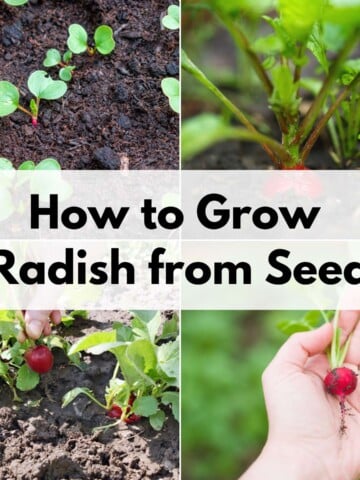
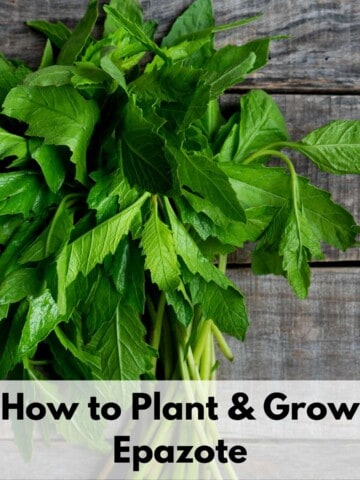
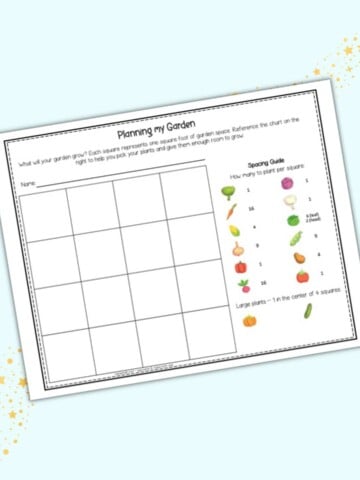
Leave a Reply